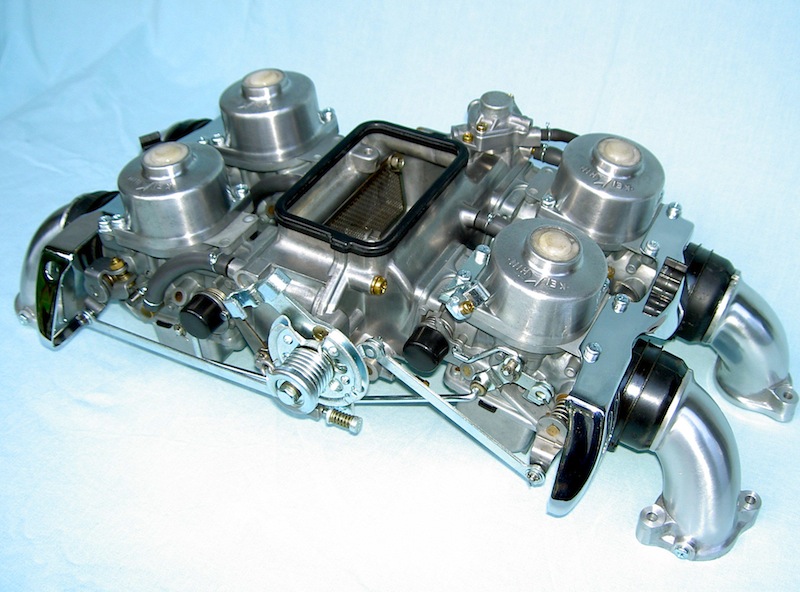You might consider this item: Randakk’s GL1000 Carb Rebuild Video
GL1000 Carb Interchange Issues
Honda GL1000 Carbs Restored by Randakk Customer Jouko Tomminen of Lahti, Finland
You might consider this item: Randakk’s GL1000 Carb Rebuild Video
GL1000 Carb Interchange Issues
Honda GL1000 Carbs Restored by Randakk Customer Jouko Tomminen of Lahti, Finland
“Prepped” Front Cover – viewed from rear. Note crucial by-pass oring detailed below.
(Special thanks to Art Jernberg for improving the captions above.)
For the static timing light needed for this procedure Click here
Robert Overby wrote a very interesting article titled “Improving Your GL1000’s Performance” which appeared in Wing World in the June 1995 issue. You can find this article by searching the GWRRA Message Board Archives (see my links page). This is a GREAT article that explains some weird design problems unique to the GL1000 ignition system as well as methods to resolve them. I guess I’m a bit of a contrarian, but I like breaker point ignition systems. In my opinion, no one needs to resort to an electronic ignition system to have a decently tuned GL1000.
This is covered in my GL1000 Carb Rebuild Video, but just in case you haven’t made that great investment…
Here’s a photo showing the location of the all-important GL1000 Carb Codes:
This Tech Tip is provided courtesy of Fred Reckling of Las Vegas, NV.
In my Honda GL1000 Carb Rebuild video, I show the method I use for testing intake runners for hidden leaks. I use rubber stoppers and a vacuum pump for this testing. My method works very well, but sometimes folks have a challenge finding the right size rubber stoppers and the hose barb needed to duplicate my rig.
Fred Reckling devised a slightly simpler method that works very well. This method works for GL1000, GL1100 and GL1200 intakes.
Continue reading “Intake Runner Leak Testing Method for Honda GL1000, GL1100 and GL1200”
Once in a while I get a question about stainless steel fasteners and why I don’t include them in my kits or offer them as an option. The short answer is that I’m in the business of helping people solve their carburetion problems, not to create new ones. If you like the bling aspect of stainless steel fasteners, then consider this.
Stainless steel makes a great looking fastener. The fact that they don’t rust is another plus. However, I don’t recommend their use in vintage Honda carburetors. Here’s why…
Continue reading “Stainless Steel Fastener Use with Vintage Honda Carbs?”
You might consider this item: Randakk’s GL1000 Carb Rebuild Video
Allow me a little soapbox time. Early GL1000s are routinely criticized for having poor carburetion. The criticism has been repeated so often by so many that it has become accepted as fact. Here is my contrarian view: the early GL1000s have great carburetion set-ups! My personal ’76 GL1000 show bike has flawless, near-linear carburetion…rheostat-like throttle response, no flat spots, starts easily, warms up fast enough and has a decent idle. My carbs are completely stock except for a few minor tweaks I make on all the carbs I service. I’ve owned and ridden many bikes. I believe the stock set-up on a GL1000, properly maintained and tuned delivers results as good as you can reasonably expect on a 4 cylinder, 4 carb bike of this vintage with this level of performance. In fact, GL1000 carburetion is easy to sort compared to some of the demonic setups I’ve encountered (my Weber-equipped Ducati 750 Nuevo Sport wins the prize as the worst I’ve ever personally grappled with).
Continue reading “How to Cure Off-Idle Flat Spot “Glitch” in Honda GL1000″
Please read: Disclaimers
Build Sheet for Supercharged CBX
Pictured below is my Supercharged CBX. This bike was Randakk’s Cycle Shakk’s test mule for R&D on high performance products for the CBX. The bike is now owned by a collector in Florida.
If you’ve read deep into this web site, you know by now that I’m “old school” on the subject of GL1000 ignitions. I happen to like old-fashioned breaker points. There are real performance advantages with electronic ignition conversions (like Dyna/S). I’ve run them on several GL1000s without complaint. But, I do field lots of questions from individuals attempting to solve various problems with aftermarket electronic ignitions systems on GL1000s. Often the problem is shoddy wiring of the switched 12V feed which powers these units. Fuses (when used!) sometimes blow without explanation. Sometimes, the “black box” circuitry inside these marvelous devices simply goes “poof.” Electronic ignitions never fail on your driveway. You’re usually at least 50 miles from home and the nearest motel!
OEM GL1000 point assembly (left) and CB450 “Black Bomber” points (right)
Continue reading “Secret Honda GL1000 Ignition Tuning Tip Revealed”
© Copyright 2025 Randakks Cycle Shakk